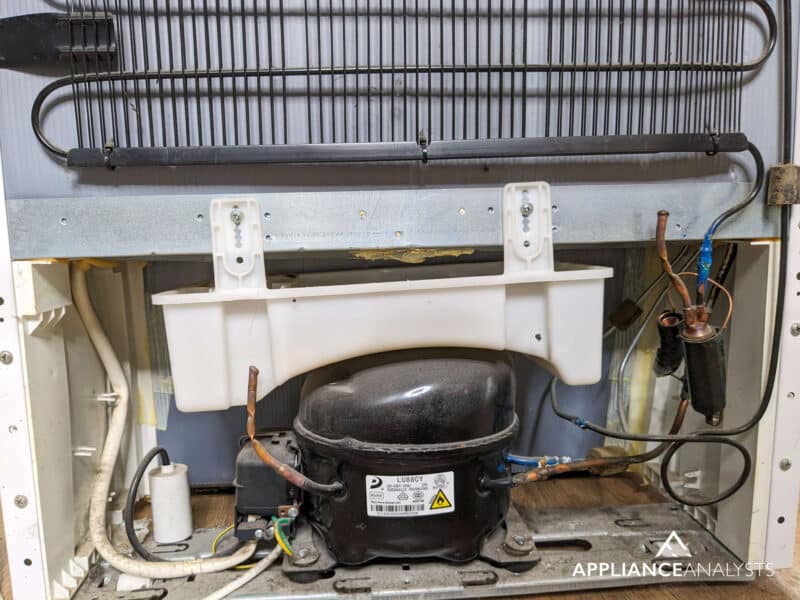Wondering if your fridge’s compressor is on the fritz?
Don’t worry – you’re not alone.
We’ve covered how to check (and fix) common compressor issues in this guide.

Finding Why Your Compressor Is Having Trouble
There are different causes of your Compressor failing, let’s list the most likely ones:
- There’s a very low load on the evaporator of the fridge. This is caused by running the fridge while it stands empty for long periods, an accumulation of ice in the freezer chamber, or a failure of the control system as possible causes. This means that the incoming refrigerant in the Compressor is in a vapor AND liquid form, the Compressor is not designed to handle that mixture, so it fails.
- Too much load in the refrigerating chamber. You’ve overstocked/overloaded the fridge or are regularly storing hot liquids etc. in it. This causes the refrigerant to get super – heated and move away from the saturated point. This causes the amount of refrigerant to increase at a much higher speed and so the Compressor needs to work both harder and for longer to achieve the same level of cooling. In these conditions your Compressor will overheat and can fail.
- Your Compressor is old and is experiencing normal wear and tear, which makes it stop working.
- You’re keeping the fridge itself in a hot place, which is causing the Compressor to overheat – causing failure.
- The refrigerant moving through the Compressor is contaminated in some way. The only 2 substances in your fridge should be refrigerant and oil. Anything else isn’t meant to be there and is considered a contaminant.
- You’re using a refrigerant that is not compatible with the Compressor/your appliance.
- Lack of lubrication. Just like the parts in your car need oil or lubricant to keep moving smoothly, lubrication is essential for a healthy compressor. Without lubrication you will have more wear and tear on the compressor, and the possibility of it overheating.
Check If Your Fridge Compressor Is Faulty
Assuming you have some technical ‘know how’, here are some things that you can try.
Remember to never work on an appliance that is still connected to a power source! Unplug the fridge entirely or make sure that it is switched off at your circuit board – leave a note on the board that it isn’t to be switched on again until you’re done working.
Check The Compressor Windings
Move the fridge away from the wall and unplug it from the wall socket.
You’re going to need a digital multi-meter for this – using the ohms function. Having electricity applied to the circuit under test will give you false readings and damage your multi meter, so unplug entirely.
Find the Compressor’s Start Relay and pull it off the terminals on the side of the Compressor.
Your fridge probably has a solid state start relay, which can be identified by the 2 wires connecting to it. The 3 pins you’ll see are marked ‘S’; ‘C’; and ‘R’. These are the Start, Common and Run winding pins. If the pins aren’t marked, set the multi meter’s function switch to the R x 1 scale, and find the 2 pins that give the highest reading – those will be your Run and Start winding pins. The pin left over is the Common pin.

If the meter L.C.D displays ‘O.L’ when checking between any 2 of the pins, the Compressor is faulty and needs to be replaced.
Check for Shorted Motor Windings
You can get 2 types of shorts in a fridge Compressor – a ‘turn to turn’ short within a winding or a ‘winding to frame’ short.
Using your trusty multi meter, the reading you get between the Run and Common and the Start and Common pins should be within .5 ohm of each other. If these readings are very different, the winding with the significantly lower reading has a ‘turn to turn’ short and the Compressor needs to be replaced.
Check also for a ‘winding to frame’ short by taking a reading between each of the pins and the Compressor housing. If the meter’s L.C.D displays anything than an ‘O.L’ during these tests, the Compressor is faulty and needs replacement.
Check the Thermostatic Control
If your motor windings have tested out well, your problem is either a faulty motor starting relay or a faulty thermostatic control switch. There is no easy way to check the solid state starting relay without substituting a new one, so let’s check the thermostatic control switch instead.
Set the switch between 4 and 5, and check for continuity between the plug and the wires attached to the start relay. The meter should display a ‘0.000’ reading between each side of the plug and one of the wires attached to the start relay. If either side gives you an ‘O.L’ reading, the thermostatic control is not working properly and you need to fit a new one.
If the check of the thermostatic control switch shows normal function, then you know that you need to replace the solid state motor starting relay.
Other Potential Issues
If your Compressor is passing all the tests electrically but is still not running normally, the Compressor could have seized up, or it might have worn or damaged bearings or valves. In other words, by law it needs to be checked further by a licensed technician registered with the E.P.A (Environmental Protection Agency).
In some cases, resetting the fridge’s compressor can do the trick.
How to Reset A Refrigerator’s Compressor
Resetting a compressor is the same way you reset a fridge (or any other appliance) – by simply turning it off and on again.
Here’s how to do it properly:
- Find the refrigerator’s power cord at the back of the appliance.
- Disconnect the power cord from the power outlet/socket. You may hear knocking noises or a whoosh noise as the power shuts off, this is normal. Leave the fridge unplugged for 5 minutes.
- Turn both the fridge and freezer controls to ‘OFF’ or ‘0’ in the fridge.
- Plug the fridge back into the power socket.
- Adjust the fridge and freezer controls to the setting that you want. Check your owner’s manual for your specific fridge to get the desired or optimal settings. On refrigerators with dials that read from ‘0’ to ‘9’, ‘5’ would be the normal setting.
- Give the fridge a day to adjust to a stable temperature.
How Much Is A New Refrigerator Compressor?
If nothing you or a technician can do has worked to repair your fridge Compressor, you will need to have a new one fitted. If you just buy the Compressor and have the technical skill to fit it yourself, this will cost you approximately $50 to $300 depending on the make and size of your fridge.
If you want to get any replacement part – or see how much one would cost – click to enter your model number in the search bar below. Our partners at AppliancePartsPros stock almost every part with free guides on how to install them.

If a technician is required to fit the new Compressor, you’re looking at the cost of the Compressor + an hourly rate for the technician, usually $100 to $200 per hour.
Make sure that your technician and the company that provides the service for you are both qualified H.V.A.C professionals and that they’re registered with the E.P.A! A reputable service provider will guarantee the longevity and quality of their workmanship for you in writing.
Ensure that any work you have done on your appliance doesn’t void the terms of your warranty agreement with the manufacturer of your appliance.
Phone around to get several quotes – a little bit of time doing your homework will save you money in the long run!
The Compressor’s Role In Refrigeration
In simple terms, the Compressor constricts or compresses the refrigerant vapor, raising its pressure, and pushes it into the coils on the outside of the refrigerator.
When the hot gas in the coils meets the colder air of your kitchen, it becomes a liquid. Now it’s a liquid at high pressure, so the refrigerant cools down as it flows into the coils inside your freezer and your fridge.
The refrigerant then absorbs the heat in your fridge, which means it cools down the air.
Lastly, the refrigerant evaporates into a gas then flows back to the Compressor to start the cycle all over again. Here’s a nifty diagram that shows the process:

Why Is It Bad If My Compressor Stops Working?
If the Compressor in your fridge stops working properly, or at all, you’re looking at a fridge that is no longer cooling. Once the fridge stops cooling, it’s not doing its job.
You’re going to end up with rotten, spoiled food, water leakage and mess as the ice of the freezer section melts, and quite possibly an expensive bill to either repair or replace the fridge.
If the Compressor has been damaged by a high voltage power surge, this can be even more problematic and expensive as the same high power surge often damages other parts of the fridge that will then need to be repaired or replaced.
So – to save ourselves hassle, time, and money it’s good to know how to find out if something is wrong with the compressor, how to look after it, and what to do if something goes wrong.







